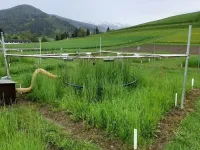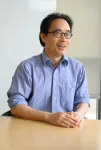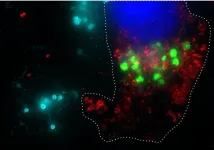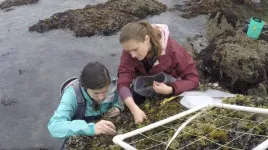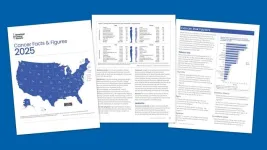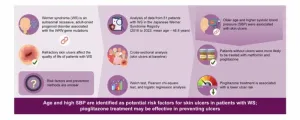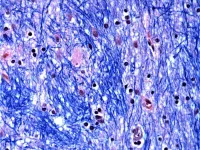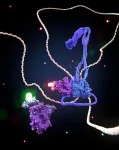(Press-News.org) The trick to creating a better quantum sensor? Just give it a little squeeze.
For the first time ever, scientists have used a technique called “quantum squeezing” to improve the gas sensing performance of devices known as optical frequency comb lasers. These ultra-precise sensors are like fingerprint scanners for molecules of gas. Scientists have used them to spot methane leaks in the air above oil and gas operations and signs of COVID-19 infections in breath samples from humans.
Now, in a series of lab experiments, researchers have laid out a path for making those kinds of measurements even more sensitive and faster—doubling the speed of frequency comb detectors. The work is a collaboration between Scott Diddams at CU Boulder Boulder and Jérôme Genest at Université Laval in Canada.
“Say you were in a situation where you needed to detect minute quantities of a dangerous gas leak in a factory setting,” said Diddams, professor in the Department of Electrical, Computer and Energy Engineering. “Requiring only 10 minutes versus 20 minutes can make a big difference in keeping people safe.”
He and his colleagues published their findings Jan. 16 in the journal Science. Daniel Herman, a postdoctoral researcher in ECEE, led the study.
While normal lasers emit light in just one color, frequency comb lasers send out pulses of thousands to millions of colors—all at the same time. In the new study, the researchers used common optical fibers to precisely manipulate the pulses coming from those lasers. They were able to “squeeze” that light, making some of its properties more precise and others a little more random.
The research, in other words, represents a victory over some of the natural randomness and fluctuations that exist in the universe at very small scales.
“Beating quantum uncertainty is hard, and it doesn’t come for free,” Diddams said. “But this is a really important step for a powerful new type of quantum sensors.”
Photon wrangling
The results represent the latest step in the evolution of frequency combs, a technology born at JILA, a joint research institute between CU Boulder and the National Institute of Standards and Technology (NIST). Diddams was part of a team led by JILA’s Jan Hall that first pioneered frequency comb lasers in the late 1990s. Hall would go on to win a Nobel Prize in Physics for this work in 2005.
As these laser pulses travel through the atmosphere, for example, molecules in the way will absorb certain colors of light, but not others. Scientists can identify what’s in the air based on what colors go missing from their laser light. Picture it a bit like a hair comb that’s lost a few of its teeth—hence, the name.
But those measurements also come with intrinsic uncertainties, Diddams said.
Light, he noted, is made up of tiny packets called photons. While lasers may look orderly from the outside, their individual photons are anything but.
“If you’re detecting these photons, they don't arrive at a perfectly uniform rate like one per nanosecond,” Diddams said. “Instead, they arrive at random times.”
Which, in turn, creates what he calls “fuzziness” in the data coming back from a frequency comb sensor.
Enter quantum squeezing.
Giving the squeeze
In quantum physics, many properties are coupled so that measuring one precisely will make your measurements of the other less precise. A classic example is the speed and location of a small particle like an electron—you can know where an electron is or how fast it’s moving, but never both at the same time. Squeezing is a technique that maximizes one type of measurement at the expense of the other.
In a series of lab experiments, Diddams and his colleagues achieved that feat in a surprisingly simple way: They sent their pulses of frequency comb light through a normal optical fiber, not so different from what delivers internet to your home.
The structure of the fiber altered the light in just the right way so that photons from the lasers now arrived at a more regular interval. But that increase in orderliness came at a price. It became a little harder to measure the frequency of the light, or how the photons oscillated to produce specific colors.
That trade-off, however, allowed the researchers to detect molecules of gas with a lot fewer errors than before.
They tested the approach out in the lab using samples of hydrogen sulfide, a molecule that is common in volcanic eruptions and smells like rotten eggs. The team reported that it could detect those molecules around twice as fast with its squeezed frequency comb than with a traditional device. The researchers were also able to achieve this effect over a range of infrared light around 1,000 times greater than what scientists had previously accomplished.
The group still has work to do before it can bring its new sensor out into the field.
“But our findings show that we are closer than ever to applying quantum frequency combs in real-world scenarios,” Herman said.
Diddams agreed: “Scientists call this a ‘quantum speedup,’” he said. “We’ve been able to manipulate the fundamental uncertainty relationships in quantum mechanics to measure something faster and better.”
Other CU Boulder co-authors of the new study included Professor Joshua Combes; graduate students Molly Kate Kreider, Noah Lordi, Eugene Tsao and Matthew Heyrich; and postdoctoral researcher Alexander Lind. Mathieu Walsh, a graduate student at Université Laval, was also a co-author.
The work at CU Boulder was supported by the U.S. National Science Foundation through the Quantum Systems through Entangled Science and Engineering (Q-SEnSE) Quantum Leap Challenge Institute and by the Office of Naval Research.
END
Quantum engineers ‘squeeze’ laser frequency combs to make more sensitive gas sensors
2025-01-16
ELSE PRESS RELEASES FROM THIS DATE:
New study reveals how climate change may alter hydrology of grassland ecosystems
2025-01-16
New research co-led by the University of Maryland reveals that drought and increased temperatures in a CO2-rich climate can dramatically alter how grasslands use and move water. The study provides the first experimental demonstration of the potential impacts of climate change on water movement through grassland ecosystems, which make up nearly 40% of Earth’s land area and play a critical role in Earth’s water cycle. The study appears in the January 17, 2025, issue of the journal Science.
“If we want to predict the effects of climate change ...
Polymer research shows potential replacement for common superglues with a reusable and biodegradable alternative
2025-01-16
EMBARGO: THIST CONTENT IS UNDER EMBARGO UNTIL 2 PM U.S. EASTERN STANDARD TIME ON JANUARY 16, 2025. INTERESTED MEDIA MAY RECIVE A PREVIEW COPY OF THE JOURNAL ARTICLE IN ADVANCE OF THAT DATE OR CONDUCT INTERVIEWS, BUT THE INFORMATION MAY NOT BE PUBLISHED, BROADCAST, OR POSTED ONLINE UNTIL AFTER THE RELEASE WINDOW.
Researchers at Colorado State University and their partners have developed an adhesive polymer that is stronger than current commercially available options while also being biodegradable ...
Research team receives $1.5 million to study neurological disorders linked to long COVID
2025-01-16
The National Institute of Mental Health has awarded a significant grant of $1.5 million to Jianyang Du, PhD, of the University of Tennessee Health Science Center, for a research study aimed at uncovering the cellular and molecular mechanisms that lead to neurological disorders caused by long COVID-19.
Dr. Du is an associate professor at the College of Medicine in the Department of Anatomy and Neurobiology. Colleen Jonsson, PhD, director of the UT Health Science Center Regional Biocontainment Laboratory and professor in the Department of Microbiology, is co-investigator on the grant, and Kun Li, PhD, assistant ...
Research using non-toxic bacteria to fight high-mortality cancers prepares for clinical trials
2025-01-16
A University of Massachusetts Amherst-Ernest Pharmaceuticals team of scientists has made “exciting,” patient-friendly advances in developing a non-toxic bacterial therapy, BacID, to deliver cancer-fighting drugs directly into tumors. This emerging technology holds promise for very safe and more effective treatment of cancers with high mortality rates, including liver, ovarian and metastatic breast cancer.
Clinical trials with participating cancer patients are estimated to begin in 2027. “This is exciting because we now have all the critical pieces for getting an effective bacterial ...
Do parents really have a favorite child? Here’s what new research says
2025-01-16
Siblings share a unique bond built from shared memories, family rituals and the occasional argument. But ask almost anyone with a brother or sister and you’ll likely find a longstanding debate: who’s the favorite? New research from BYU sheds some light on that playful rivalry, revealing how parents might subtly show favoritism based on birth order, personality and gender.
The study, conducted by BYU School of Family Life professor Alex Jensen, found that younger siblings generally receive more favorable ...
Mussel bed surveyed before World War II still thriving
2025-01-16
A mussel bed along Northern California’s Dillon Beach is as healthy and biodiverse as it was about 80 years ago, when two young students surveyed it shortly before Pearl Harbor was attacked and one was sent to fight in World War II.
Their unpublished, typewritten manuscript sat in the UC Davis Bodega Marine Laboratory’s library for years until UC Davis scientists found it and decided to resurvey the exact same mussel bed with the old paper’s meticulous photos and maps directing their way.
The new findings, published in the journal Scientific Reports, document ...
ACS Annual Report: Cancer mortality continues to drop despite rising incidence in women; rates of new diagnoses under 65 higher in women than men
2025-01-16
ATLANTA, January 16, 2025 — The American Cancer Society (ACS) today released Cancer Statistics, 2025, the organization’s annual report on cancer facts and trends. The new findings show the cancer mortality rate declined by 34% from 1991 to 2022 in the United States, averting approximately 4.5 million deaths. However, this steady progress is jeopardized by increasing incidence for many cancer types, especially among women and younger adults, shifting the burden of disease. For example, incidence rates in women 50-64 years of age have surpassed those in ...
Fewer skin ulcers in Werner syndrome patients treated with pioglitazone
2025-01-16
“[…] the results of this study indicate that pioglitazone might be useful in treating refractory skin ulcers, a typical condition that reduces the quality of life of patients with WS.”
BUFFALO, NY- January 16, 2025 – A new research paper was published in Aging (listed by MEDLINE/PubMed as “Aging (Albany NY)” and “Aging-US” by Web of Science) Volume 16, Issue 22 on December 2, 2024, entitled “Less frequent skin ulcers among patients with Werner syndrome treated with pioglitazone: findings from the Japanese Werner Syndrome Registry.”
Scientists ...
Study finds surprising way that genetic mutation causes Huntington’s disease, transforming understanding of the disorder
2025-01-16
Scientists at the Broad Institute of MIT and Harvard, Harvard Medical School, and McLean Hospital have discovered a surprising mechanism by which the inherited genetic mutation known to cause Huntington’s disease leads to the death of brain cells. The findings change the understanding of the fatal neurodegenerative disorder and suggest potential ways to delay or even prevent it.
For 30 years, researchers have known that Huntington’s is caused by an inherited mutation in the Huntingtin (HTT) gene, but they didn’t ...
DNA motors found to switch gears
2025-01-16
Scientists from Delft, Vienna, and Lausanne discovered that the protein machines that shape our DNA can switch direction. Until now, researchers believed that these so-called SMC motors that make loops into DNA could move in one direction only. The discovery, which is published in Cell, is key to understanding how these motors shape our genome and regulate our genes.
Connecting DNA
“Sometimes, a cell needs to be quick in changing which genes should be expressed and which ones should be turned off, for example in response to food, alcohol or heat. To turn genes off and on, cells use Structural Maintenance ...
